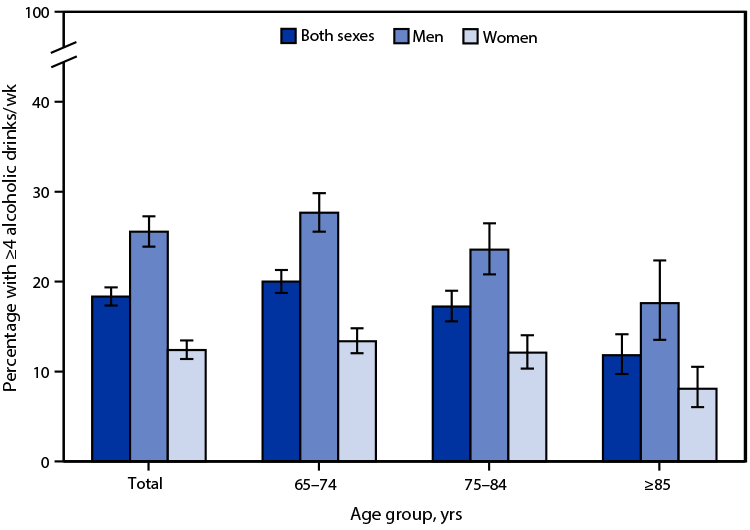QuickStats: Percentage* of Adults Aged ≥65 Years Who Drank Four or More Alcoholic Drinks Per Week,† by Sex and Age — National Health Interview Survey, United States, 2020§
Weekly / August 19, 2022 / 71(33);1069
Altmetric:

* With 95% CIs indicated by error bars.
† Based on responses to a series of questions about consumption of alcoholic beverages for adults who had at least one drink in their lifetime.
§ Estimates are based on household interviews of a sample of the civilian, noninstitutionalized U.S. population.
In 2020, 18.3% of adults aged ≥65 years reported drinking four or more alcoholic drinks per week. Among adults aged ≥65 years, men were more likely (25.6%) than women (12.4%) to have four or more drinks. Percentages of those having four or more drinks were higher among men than women for the following age groups: 65–74 years (27.7% versus 13.4%), 75–84 years (23.6% versus 12.1%) and ≥85 years (17.6% versus 8.1%). Among both men and women, the percentage of adults aged ≥65 years who drank four or more alcoholic drinks per week decreased as age increased, from 20.0% for those aged 65–74 years to 11.8% for those aged ≥85 years.
Source: National Health Interview Survey, 2020. https://www.cdc.gov/nchs/nhis.htm
Reported by: Robin A. Cohen, PhD, rzc6@cdc.gov, 301-458-4152; Michael E. Martinez, MPH, MHSA.
For more information on this topic, CDC recommends the following link: https://www.cdc.gov/alcohol/index.htm
Suggested citation for this article: Percentage of Adults Aged ≥65 Years Who Drank Four or More Alcoholic Drinks Per Week, by Sex and Age — National Health Interview Survey, United States, 2020. MMWR Morb Mortal Wkly Rep 2022;71:1069. DOI: http://dx.doi.org/10.15585/mmwr.mm7133a5.
MMWR and Morbidity and Mortality Weekly Report are service marks of the U.S. Department of Health and Human Services.
Use of trade names and commercial sources is for identification only and does not imply endorsement by the U.S. Department of
Health and Human Services.
References to non-CDC sites on the Internet are
provided as a service to MMWR readers and do not constitute or imply
endorsement of these organizations or their programs by CDC or the U.S.
Department of Health and Human Services. CDC is not responsible for the content
of pages found at these sites. URL addresses listed in MMWR were current as of
the date of publication.
All HTML versions of MMWR articles are generated from final proofs through an automated process. This conversion might result in character translation or format errors in the HTML version. Users are referred to the electronic PDF version (https://www.cdc.gov/mmwr) and/or the original MMWR paper copy for printable versions of official text, figures, and tables.
Questions or messages regarding errors in formatting should be addressed to mmwrq@cdc.gov.